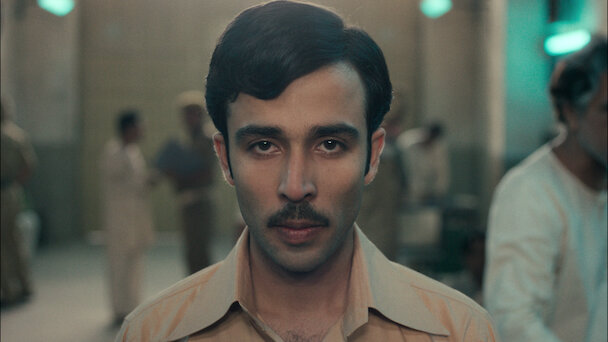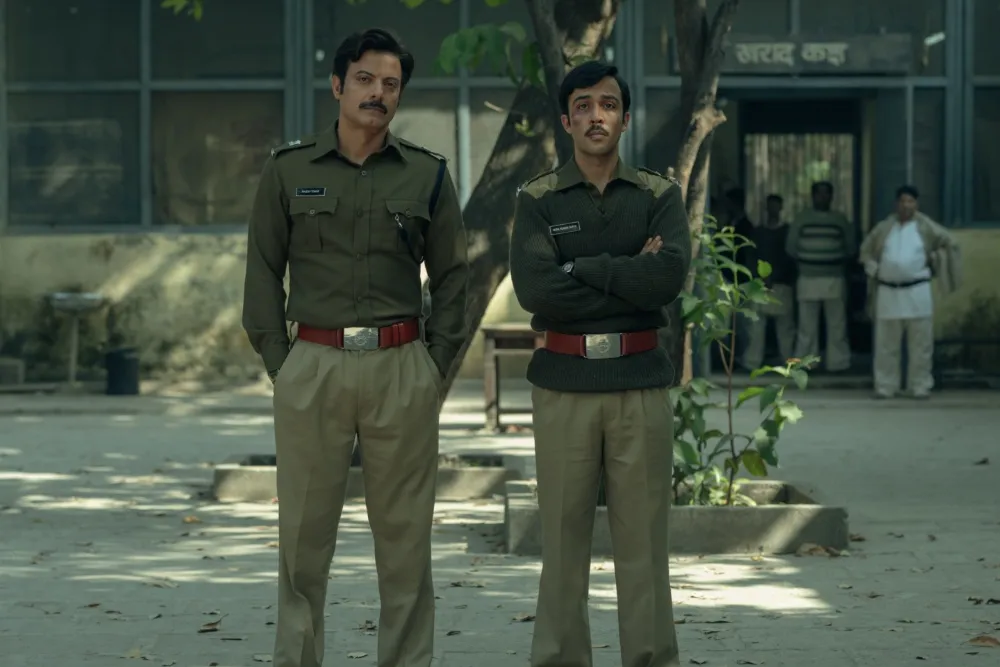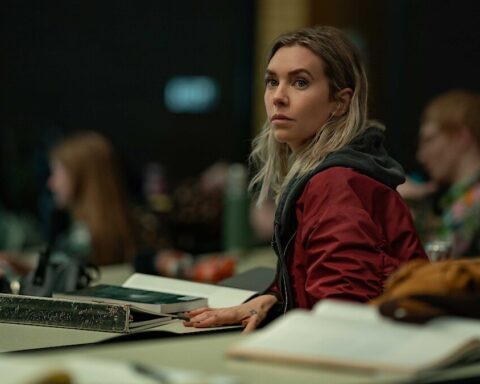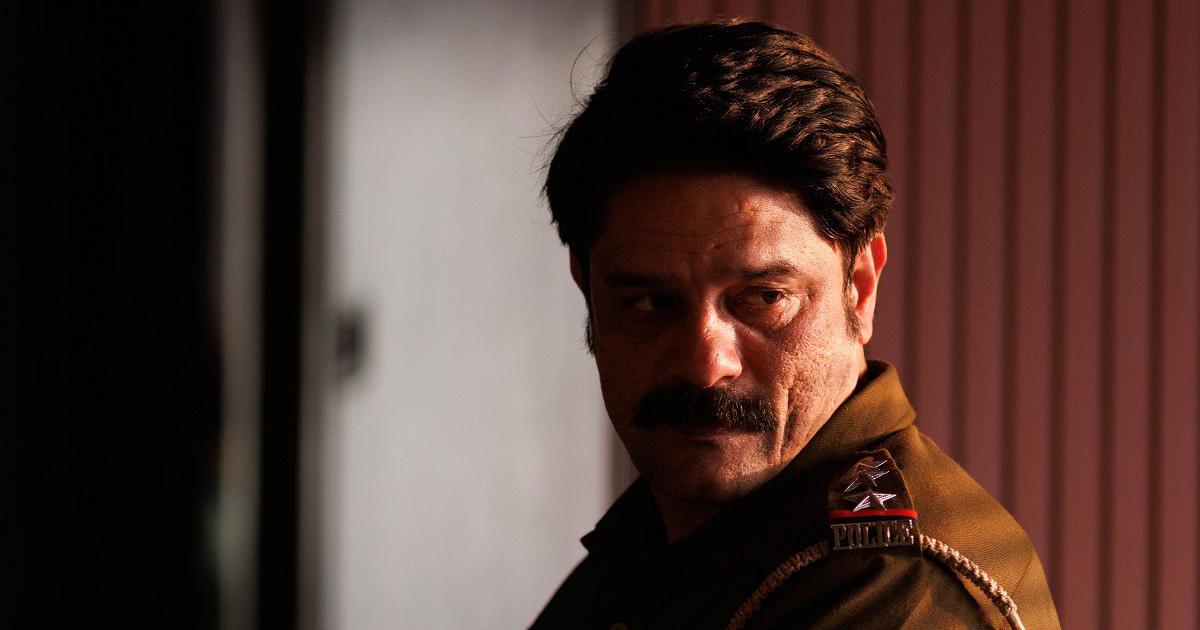The Netflix series, Black Warrant, created by Vikramaditya Motwane and Satyanshu Singh, is a drama set in one of Asia’s largest prisons, Tihar Jail. Based on the titular book by Sunil Gupta and journalist Sunetra Choudhury, through seven episodes, the series charts some of the notorious historical events from 1981 to 1986, that witnessed some of the most significant and turbulent times within the prison’s walls, affecting the lives of both the administration and the prison inmates. As the protagonist, a newly appointed young jailer, maneuvers and adapts to the tough and corrupt ecosystem of the prison while simultaneously balancing his personal life, we witness how a microcosm of the nation itself unfolds within the confines of the jail.
Sunil Gupta (Zahan Kapoor), hailing from a middle-class family, desperately needs a job. An advertisement in the employment exchange leads him to an unexpected opportunity: a position as a jailer at Tihar Jail. Under the watchful eye of DSP Rajesh Tomar (Rahul Bhat), Sunil, alongside his newly appointed colleagues Mangat (Paramvir Singh Cheema) and Dahiya (Anurag Thakur), diligently learns the ropes of his challenging new role. As Sunil confronts one daunting situation after another, he realizes the immense weight of his responsibilities. He further discovers that some inmates are languishing behind bars due to their inability to afford legal representation. Driven by a sense of justice, Sunil embarks on a mission to establish a legal aid system within the prison, inadvertently sparking a bitter rivalry with Tomar, and setting in motion a chain of events that will irrevocably alter the course of his life.
Helmed by a talented team of directors including Vikramaditya Motwane, Satyanshu Singh, Arkesh Ajay, Rohin Raveendran, and Ambreen Pandit, Black Warrant excels in its unflinching portrayal of prison life, showcasing its grim, gritty, and grounded realities The race to kill a snake can earn an inmate a remission of fifteen days, a brutal incentive that can create bloody rivalries amongst two gangs in the prison. Economically deprived prisoners are relegated to C-class prisons, while well-connected prisoners, who can occasionally grease the palms of prison officials, are kept in B-class prisons. But a high-profile prisoner can have a single cell all to himself, enjoying all the prison’s amenities. The hanging of a prisoner has to be dealt with meticulous caution, akin to a well-organized ritual. Such information paints a stark and unflinching portrait of the harsh realities of prison life. Written by Motwane, Singh, and Ajay, the series is built essentially on fact, with most of it unfolding within the confines of the prison. The essential details of the plot are meticulously rooted in documented reality, unobtrusively woven into the narrative. The retention of the names of principal figures, like Charles Sobhraj, Maqbool Bhat, or Billa-Ranga, lends an undeniable authenticity to the narrative and allows for a more visceral experience of the dramatic ebbs and flows. Ultimately, it adds up to a disquieting story that delves not only into the daily struggles of a police team striving to maintain discipline and peace within the prison walls but also serves as a chilling reflection of a society grappling with its ugly underbelly and myriad fault lines.

The series begins with a humorous observation of how the newly appointed, lean, and non-violent Sunil acclimatizes to the unforgiving environment of the prison. He witnesses firsthand how an execution by hanging can transform into a brutal act of “getting the job done,” forcing him to confront the blurred lines between right and wrong. As Sunil gradually evolves into a hardened individual who begins to understand the intricate workings of the prison hierarchy, he experiences a meaningful awakening – a realization that he can potentially affect substantial change within the system by providing legal aid to impoverished prisoners who cannot afford representation. However, the higher officials, their positions deeply entrenched in corruption, vehemently oppose his efforts. Despite being a seemingly insignificant cog in the vast machinery of the prison system, Sunil persists in his pursuit of justice. Moreover, whenever Sunil finds himself at his wit’s end, he seeks counsel from Sobhraj, who invariably provides him with insightful and pragmatic solutions. This creates a perverse irony within the system, where in his quest for justice, finds himself entangled in the very web of corruption he seeks to dismantle.
Zahan Kapoor delivers a compelling performance, navigating a complex spectrum of emotions – from simmering anger and deep-seated trauma to unwavering determination and weary resignation. Beneath the surface of his controlled demeanour, a simmering fury constantly threatens to erupt. Rahul Bhat, as DSP Rajesh Tomar, leaves an indelible mark, commanding respect through a blend of toughness and unwavering authority. He quickly earns his superior’s trust with his assertive yet measured approach. Paramvir Singh Cheema as Mangat and Anurag Thakur as Dahiya both bring a refreshing energy and undeniable charisma to their roles, solidifying their presence as capable and confident officers. Tota Roy Choudhury, despite his limited screen time as SP Mukhopadhyay, makes a significant impact with his powerful presence and unwavering conviction. Sidhant Gupta embodies the enigmatic Charles Sobhraj, capturing the character’s cunning intellect with a chilling blend of calm composure and calculated ruthlessness. Rajendra Gupta, as the conflicted accountant Saini, provides a much-needed human element to the narrative. He grapples internally with the rampant corruption he witnesses, striving to maintain a professional facade while grappling with his moral compass. The female characters, while often confined to stereotypical archetypes – the romantic interest (Saamy Jainn), the unfaithful wife (Megha Burman), and the investigative journalist (Rajshri Deshpande) – nonetheless contribute a unique gravity to the narrative.
The cinematography by Cinematographer Saumyananda Sahi captures the prison and the dilemmas of the principal characters with a raw, almost documentary-like quality that gives the series its gritty edge. The editing by Tanya Chhabria brings a seamless rhythm to the events of the various episodes with fluidity. Kunal Sharma’s sound design brings a realism that immerses us in the stifling atmosphere of prison life. Mukund Gupta’s production design of the prison and the exteriors authentically recreates the flavour of the 1980s, transporting us back to that era.
However, the final episodes exhibit a noticeable sense of haste. At the same time, the portrayal of the characters’ personal lives occasionally succumbs to cliché, detracting somewhat from the overall impact of the series. Despite these minor shortcomings, the series remains a compelling watch, thanks to its impeccable execution, sharp attention to detail, technical finesse, and outstanding performances.






